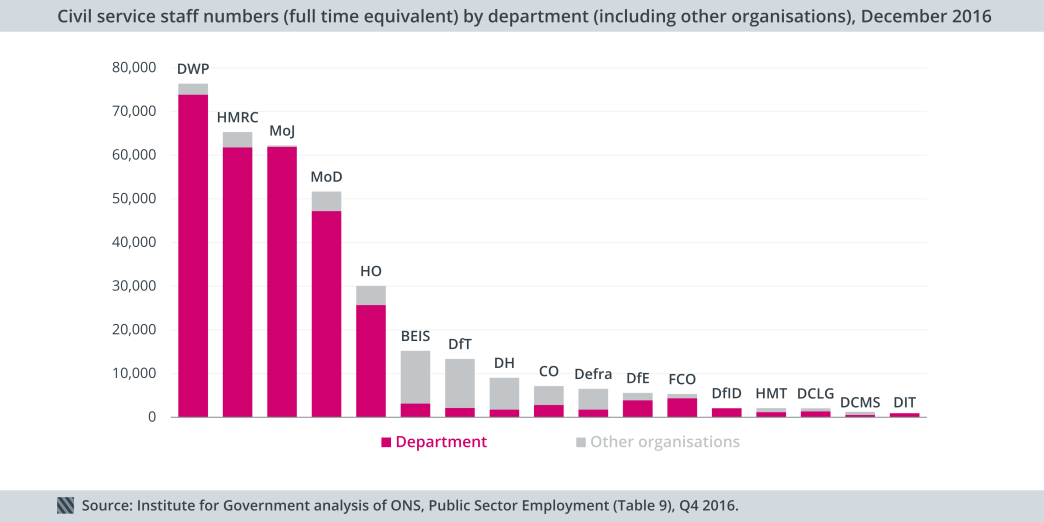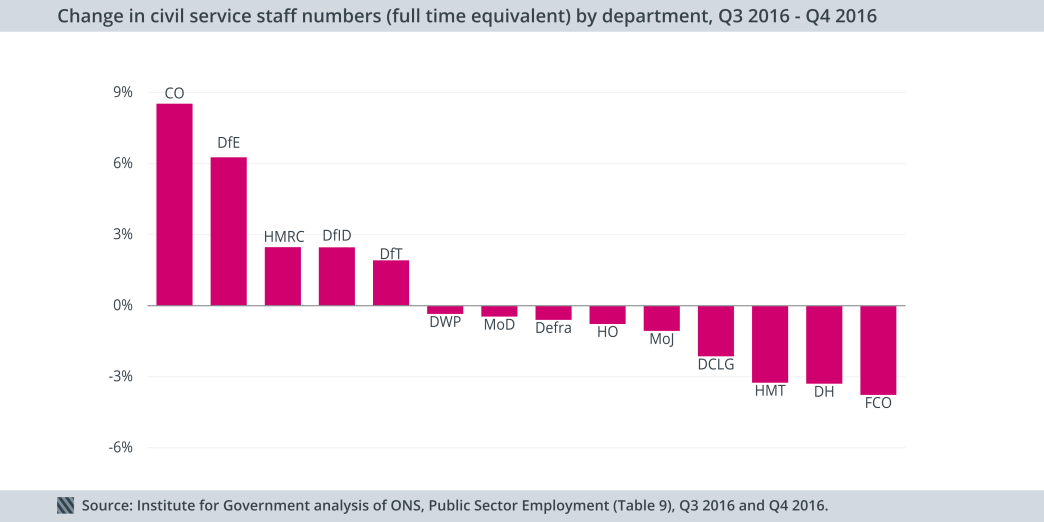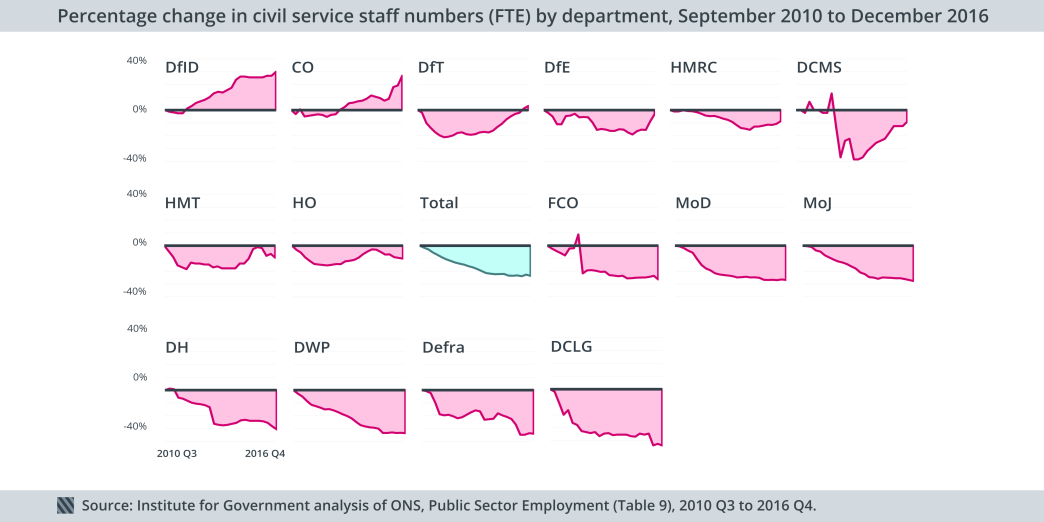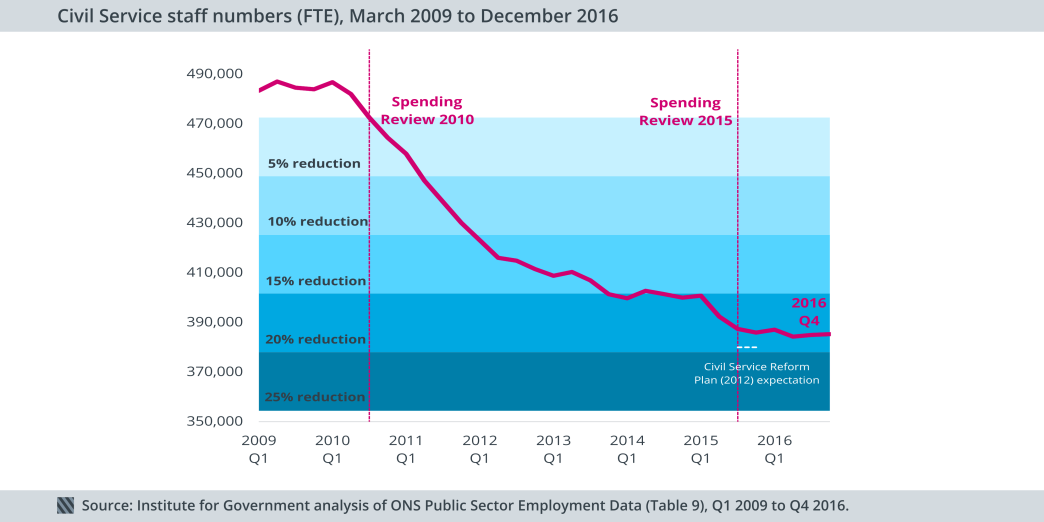The latest ONS data shows that cuts to the civil service are tailing off as it gets ready for Brexit. But Alice Lilly says we still don’t know how many civil servants are working in the department responsible for it, DExEU.
The pace of reductions is slowing.
With Article 50 imminently due to be triggered, the IfG has explored the challenges and capacity of the civil service in preparing for and managing negotiations, as well as in implementing Brexit.
Yesterday’s Office for National Statistic (ONS) figures, which give a snapshot of the civil service at the end of December 2016, show there were 385,280 civil servants at full-time equivalent (FTE), 330 more than in the previous quarter.

Although the civil service remains far smaller than in 2010 – a cumulative reduction of 19% – the very slight increase in overall staff numbers, combined with the small increase seen in the previous quarter, suggests that the pace of staff cuts may be tailing off as we prepare for Brexit negotiations.
We still don’t have the headcount numbers for DExEU.
This release contains the first figures for BEIS and DIT – but not for DExEU, whose staff, according to the ONS, are either still on the payroll of their previous department (if they have transferred into DExEU from another department) or (if they are new employees) are reported under Cabinet Office (CO) figures.
The fact we still can’t get figures for DExEU some nine months after its creation highlights that making changes to the machinery of government can be time-consuming and complex, as the IfG has warned.
At a time when departments are juggling Brexit preparations with delivering the Government’s other commitments – and simply getting on with everyday business – it is vital that they have accurate information on their workforce in order to effectively plan their resources.

Of the new departments, BEIS is the sixth largest departmental group, with 15,190 staff overall—slightly more than BIS had before its abolition. DIT has 910 staff, replacing DCMS as the smallest departmental group. According to the ONS, around 700 of these transferred from BIS, with the rest coming from the UK Trade and Investment (UKTI) part of the FCO.
The largest departmental groups remain DWP, HMRC, and MoJ. Together, they account for over half of the civil service.
HMRC has seen an increase in staff in the last quarter…

Two of the departments that have seen the largest percentage increases in staff numbers in the last quarter were the Cabinet Office and HMRC, both of whom are likely to be particularly affected by Brexit. The Cabinet Office saw an increase of 8.5%, although this may be partly explained by the fact that some DExEU staff are reported under it.
HMRC has also seen an increase: in the last quarter of 2016, its core staff numbers rose by 1,490 (a 2.5% increase, given the size of the department), compared to the previous quarter, where they rose by 580.
But other departments, including those likely to be heavily affected by Brexit – the Home Office and Defra – continued to see slight decreases in their workforces. DH saw another fall in numbers (3.3%), following a fall of 3.7% in the previous quarter. HM Treasury and the FCO also saw reductions in staff levels, having both experienced small increases in the previous quarter.
…but Defra remains much smaller than in 2010.

Some of the big delivery departments – MoJ, DWP, and DH – have also all seen their staff fall by over a quarter on 2010 levels. The notable exception to this is HMRC, which has experienced lower cuts that appear to be tailing off.
Other departments have seen staff levels rise since 2010. DfID has experienced a cumulative rise of 30%, while the Cabinet Office has grown by just over a quarter, although this may be revised once separate numbers for DExEU are available.
As the IfG noted this week, Brexit creates a number of challenges for a civil service that remains far smaller than in 2010. The pace of reductions appears to be slowing – but it remains to be seen whether this continues. The next figures, published in June, will give us a good indication – and hopefully, our first glimpse of staff levels at DExEU.
- Supporting document
- IFGJ5327_Report_Brexit_Civil_Service_080317_WEB.pdf (PDF, 664.8 KB)
- Topic
- Civil service